ACCT20080 Report: Ethical Considerations in the Enron Scandal Analysis
VerifiedAdded on 2022/09/07
|17
|4220
|18
Report
AI Summary
This report delves into the Enron scandal, a significant case of corporate fraud and ethical misconduct. It explores the ethical theories of Egoism and Deontology, contrasting their application to the Enron case, where executives prioritized personal gain over stakeholder interests and ethical conduct. The report then examines the American Accounting Association (AAA) model for ethical decision-making, illustrating how accountants could have used it to navigate the ethical dilemmas presented by Enron's fraudulent practices. Furthermore, it discusses the Sarbanes-Oxley (SOX) Act of 2002, enacted in response to scandals like Enron, highlighting its impact on corporate governance, financial reporting, and investor protection. The analysis underscores the importance of ethical leadership, robust financial reporting, and the role of accountants in maintaining the integrity of the financial system. The report concludes by emphasizing the negative consequences of Enron's actions on its stakeholders, including employees, shareholders, and the broader economy, reinforcing the need for ethical behavior in business and the implementation of strong internal controls.
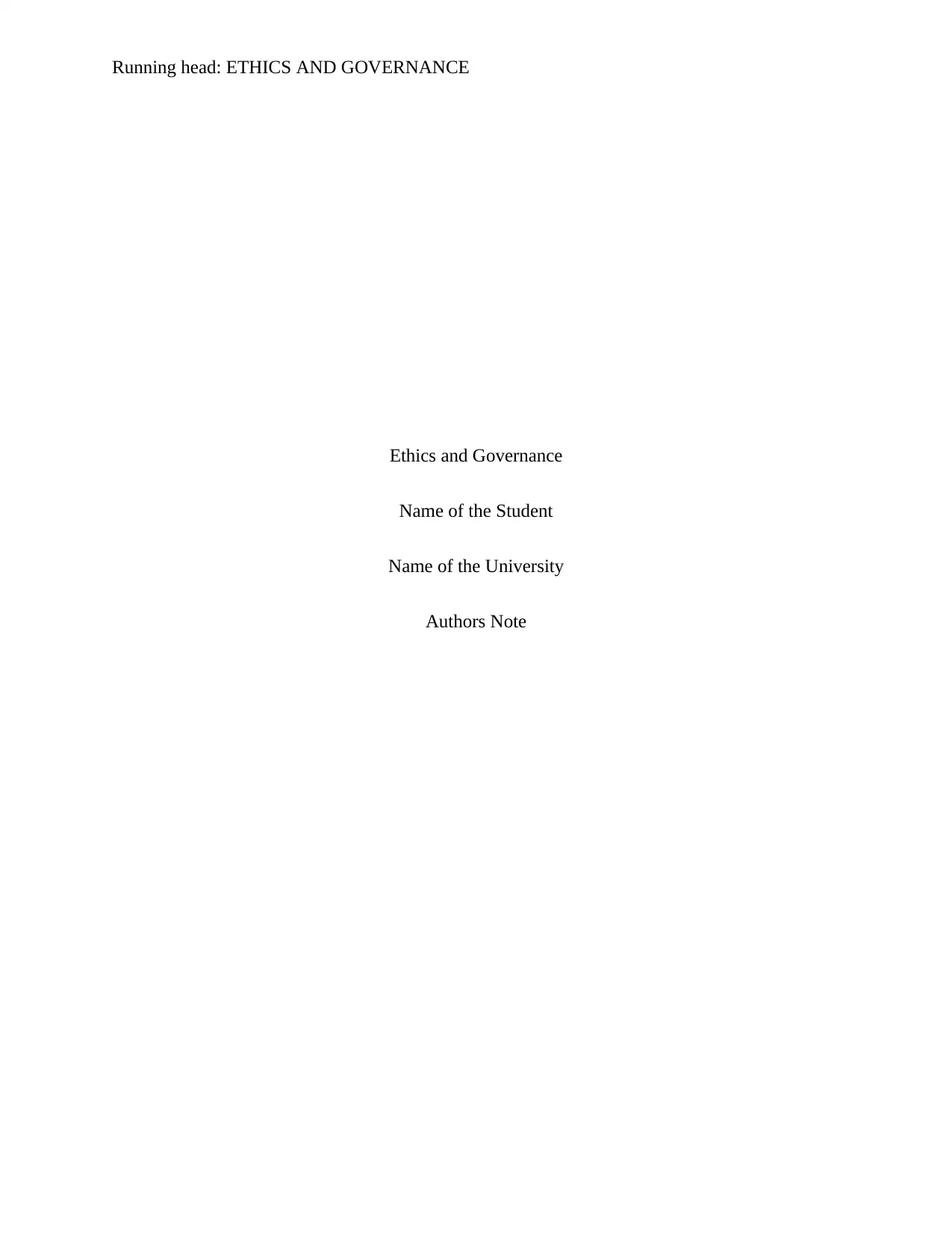
Running head: ETHICS AND GOVERNANCE
Ethics and Governance
Name of the Student
Name of the University
Authors Note
Ethics and Governance
Name of the Student
Name of the University
Authors Note
Paraphrase This Document
Need a fresh take? Get an instant paraphrase of this document with our AI Paraphraser
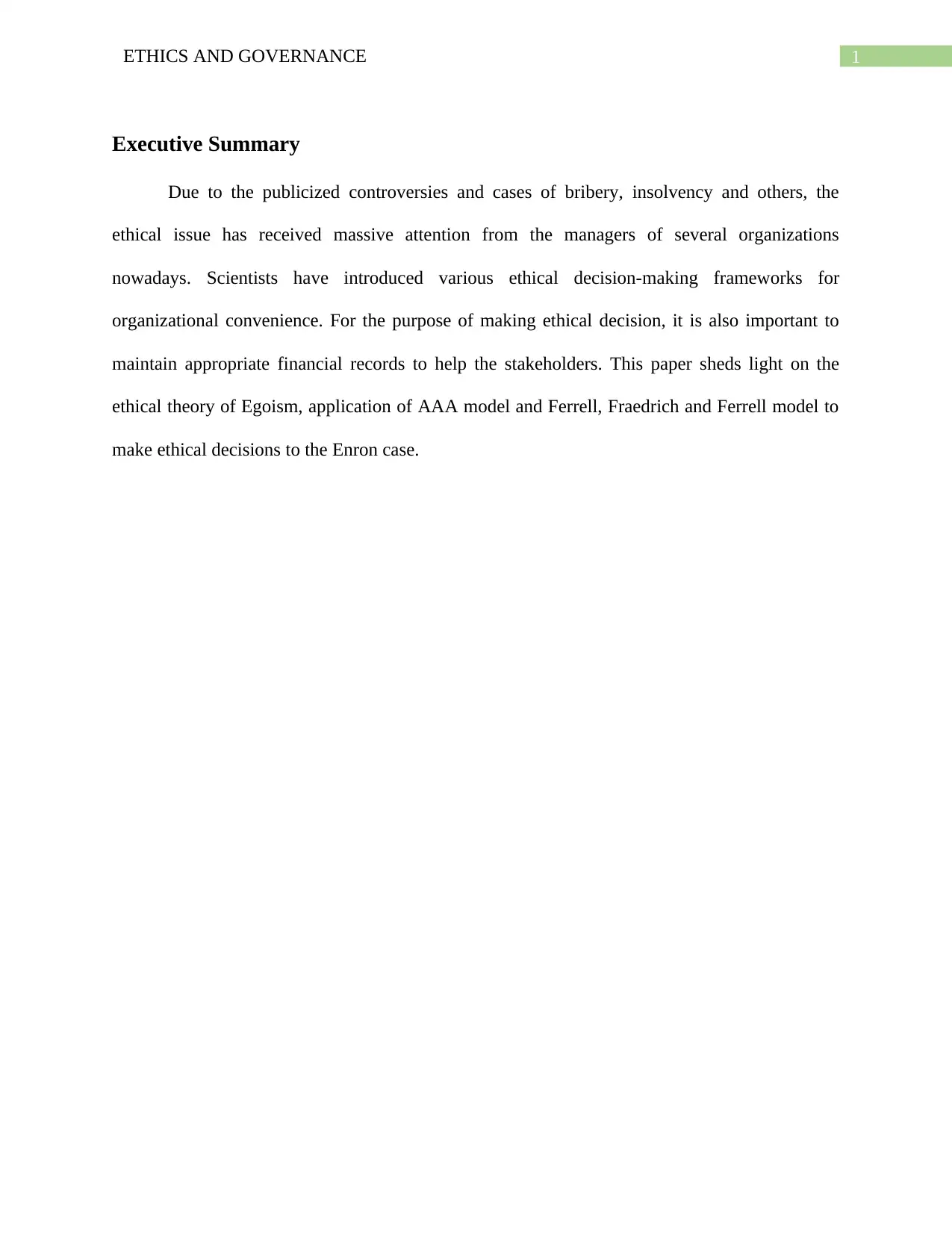
1ETHICS AND GOVERNANCE
Executive Summary
Due to the publicized controversies and cases of bribery, insolvency and others, the
ethical issue has received massive attention from the managers of several organizations
nowadays. Scientists have introduced various ethical decision-making frameworks for
organizational convenience. For the purpose of making ethical decision, it is also important to
maintain appropriate financial records to help the stakeholders. This paper sheds light on the
ethical theory of Egoism, application of AAA model and Ferrell, Fraedrich and Ferrell model to
make ethical decisions to the Enron case.
Executive Summary
Due to the publicized controversies and cases of bribery, insolvency and others, the
ethical issue has received massive attention from the managers of several organizations
nowadays. Scientists have introduced various ethical decision-making frameworks for
organizational convenience. For the purpose of making ethical decision, it is also important to
maintain appropriate financial records to help the stakeholders. This paper sheds light on the
ethical theory of Egoism, application of AAA model and Ferrell, Fraedrich and Ferrell model to
make ethical decisions to the Enron case.
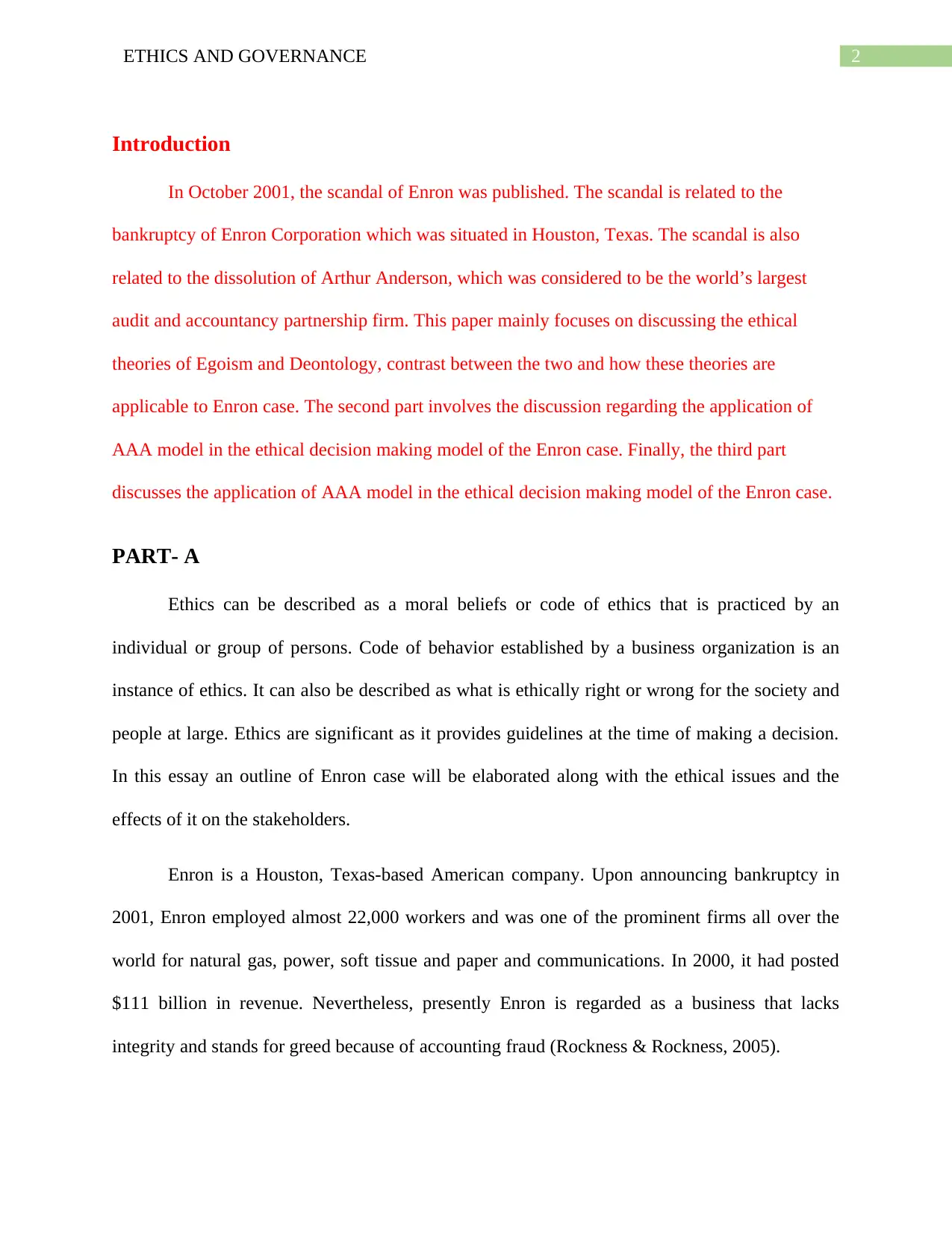
2ETHICS AND GOVERNANCE
Introduction
In October 2001, the scandal of Enron was published. The scandal is related to the
bankruptcy of Enron Corporation which was situated in Houston, Texas. The scandal is also
related to the dissolution of Arthur Anderson, which was considered to be the world’s largest
audit and accountancy partnership firm. This paper mainly focuses on discussing the ethical
theories of Egoism and Deontology, contrast between the two and how these theories are
applicable to Enron case. The second part involves the discussion regarding the application of
AAA model in the ethical decision making model of the Enron case. Finally, the third part
discusses the application of AAA model in the ethical decision making model of the Enron case.
PART- A
Ethics can be described as a moral beliefs or code of ethics that is practiced by an
individual or group of persons. Code of behavior established by a business organization is an
instance of ethics. It can also be described as what is ethically right or wrong for the society and
people at large. Ethics are significant as it provides guidelines at the time of making a decision.
In this essay an outline of Enron case will be elaborated along with the ethical issues and the
effects of it on the stakeholders.
Enron is a Houston, Texas-based American company. Upon announcing bankruptcy in
2001, Enron employed almost 22,000 workers and was one of the prominent firms all over the
world for natural gas, power, soft tissue and paper and communications. In 2000, it had posted
$111 billion in revenue. Nevertheless, presently Enron is regarded as a business that lacks
integrity and stands for greed because of accounting fraud (Rockness & Rockness, 2005).
Introduction
In October 2001, the scandal of Enron was published. The scandal is related to the
bankruptcy of Enron Corporation which was situated in Houston, Texas. The scandal is also
related to the dissolution of Arthur Anderson, which was considered to be the world’s largest
audit and accountancy partnership firm. This paper mainly focuses on discussing the ethical
theories of Egoism and Deontology, contrast between the two and how these theories are
applicable to Enron case. The second part involves the discussion regarding the application of
AAA model in the ethical decision making model of the Enron case. Finally, the third part
discusses the application of AAA model in the ethical decision making model of the Enron case.
PART- A
Ethics can be described as a moral beliefs or code of ethics that is practiced by an
individual or group of persons. Code of behavior established by a business organization is an
instance of ethics. It can also be described as what is ethically right or wrong for the society and
people at large. Ethics are significant as it provides guidelines at the time of making a decision.
In this essay an outline of Enron case will be elaborated along with the ethical issues and the
effects of it on the stakeholders.
Enron is a Houston, Texas-based American company. Upon announcing bankruptcy in
2001, Enron employed almost 22,000 workers and was one of the prominent firms all over the
world for natural gas, power, soft tissue and paper and communications. In 2000, it had posted
$111 billion in revenue. Nevertheless, presently Enron is regarded as a business that lacks
integrity and stands for greed because of accounting fraud (Rockness & Rockness, 2005).
⊘ This is a preview!⊘
Do you want full access?
Subscribe today to unlock all pages.

Trusted by 1+ million students worldwide
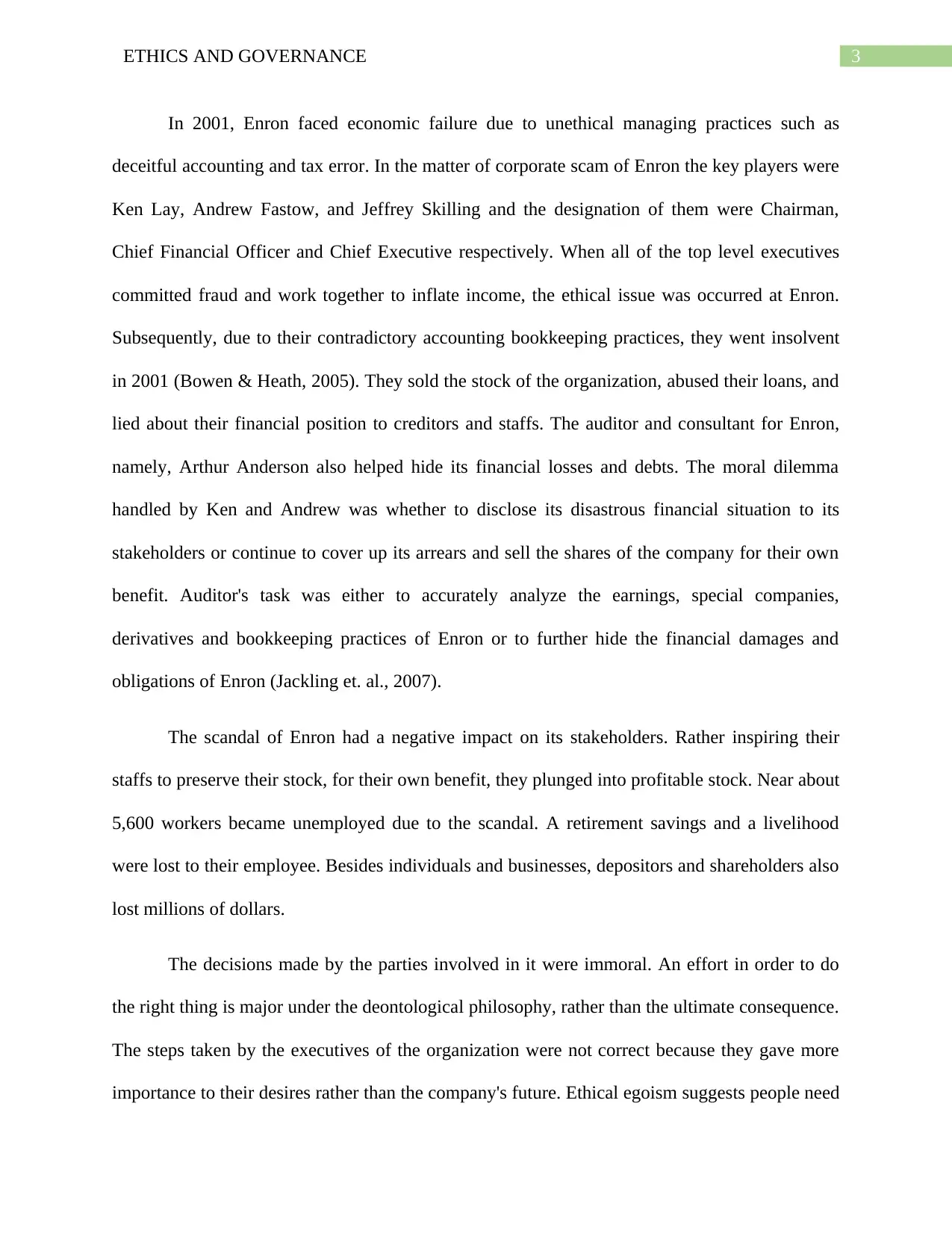
3ETHICS AND GOVERNANCE
In 2001, Enron faced economic failure due to unethical managing practices such as
deceitful accounting and tax error. In the matter of corporate scam of Enron the key players were
Ken Lay, Andrew Fastow, and Jeffrey Skilling and the designation of them were Chairman,
Chief Financial Officer and Chief Executive respectively. When all of the top level executives
committed fraud and work together to inflate income, the ethical issue was occurred at Enron.
Subsequently, due to their contradictory accounting bookkeeping practices, they went insolvent
in 2001 (Bowen & Heath, 2005). They sold the stock of the organization, abused their loans, and
lied about their financial position to creditors and staffs. The auditor and consultant for Enron,
namely, Arthur Anderson also helped hide its financial losses and debts. The moral dilemma
handled by Ken and Andrew was whether to disclose its disastrous financial situation to its
stakeholders or continue to cover up its arrears and sell the shares of the company for their own
benefit. Auditor's task was either to accurately analyze the earnings, special companies,
derivatives and bookkeeping practices of Enron or to further hide the financial damages and
obligations of Enron (Jackling et. al., 2007).
The scandal of Enron had a negative impact on its stakeholders. Rather inspiring their
staffs to preserve their stock, for their own benefit, they plunged into profitable stock. Near about
5,600 workers became unemployed due to the scandal. A retirement savings and a livelihood
were lost to their employee. Besides individuals and businesses, depositors and shareholders also
lost millions of dollars.
The decisions made by the parties involved in it were immoral. An effort in order to do
the right thing is major under the deontological philosophy, rather than the ultimate consequence.
The steps taken by the executives of the organization were not correct because they gave more
importance to their desires rather than the company's future. Ethical egoism suggests people need
In 2001, Enron faced economic failure due to unethical managing practices such as
deceitful accounting and tax error. In the matter of corporate scam of Enron the key players were
Ken Lay, Andrew Fastow, and Jeffrey Skilling and the designation of them were Chairman,
Chief Financial Officer and Chief Executive respectively. When all of the top level executives
committed fraud and work together to inflate income, the ethical issue was occurred at Enron.
Subsequently, due to their contradictory accounting bookkeeping practices, they went insolvent
in 2001 (Bowen & Heath, 2005). They sold the stock of the organization, abused their loans, and
lied about their financial position to creditors and staffs. The auditor and consultant for Enron,
namely, Arthur Anderson also helped hide its financial losses and debts. The moral dilemma
handled by Ken and Andrew was whether to disclose its disastrous financial situation to its
stakeholders or continue to cover up its arrears and sell the shares of the company for their own
benefit. Auditor's task was either to accurately analyze the earnings, special companies,
derivatives and bookkeeping practices of Enron or to further hide the financial damages and
obligations of Enron (Jackling et. al., 2007).
The scandal of Enron had a negative impact on its stakeholders. Rather inspiring their
staffs to preserve their stock, for their own benefit, they plunged into profitable stock. Near about
5,600 workers became unemployed due to the scandal. A retirement savings and a livelihood
were lost to their employee. Besides individuals and businesses, depositors and shareholders also
lost millions of dollars.
The decisions made by the parties involved in it were immoral. An effort in order to do
the right thing is major under the deontological philosophy, rather than the ultimate consequence.
The steps taken by the executives of the organization were not correct because they gave more
importance to their desires rather than the company's future. Ethical egoism suggests people need
Paraphrase This Document
Need a fresh take? Get an instant paraphrase of this document with our AI Paraphraser
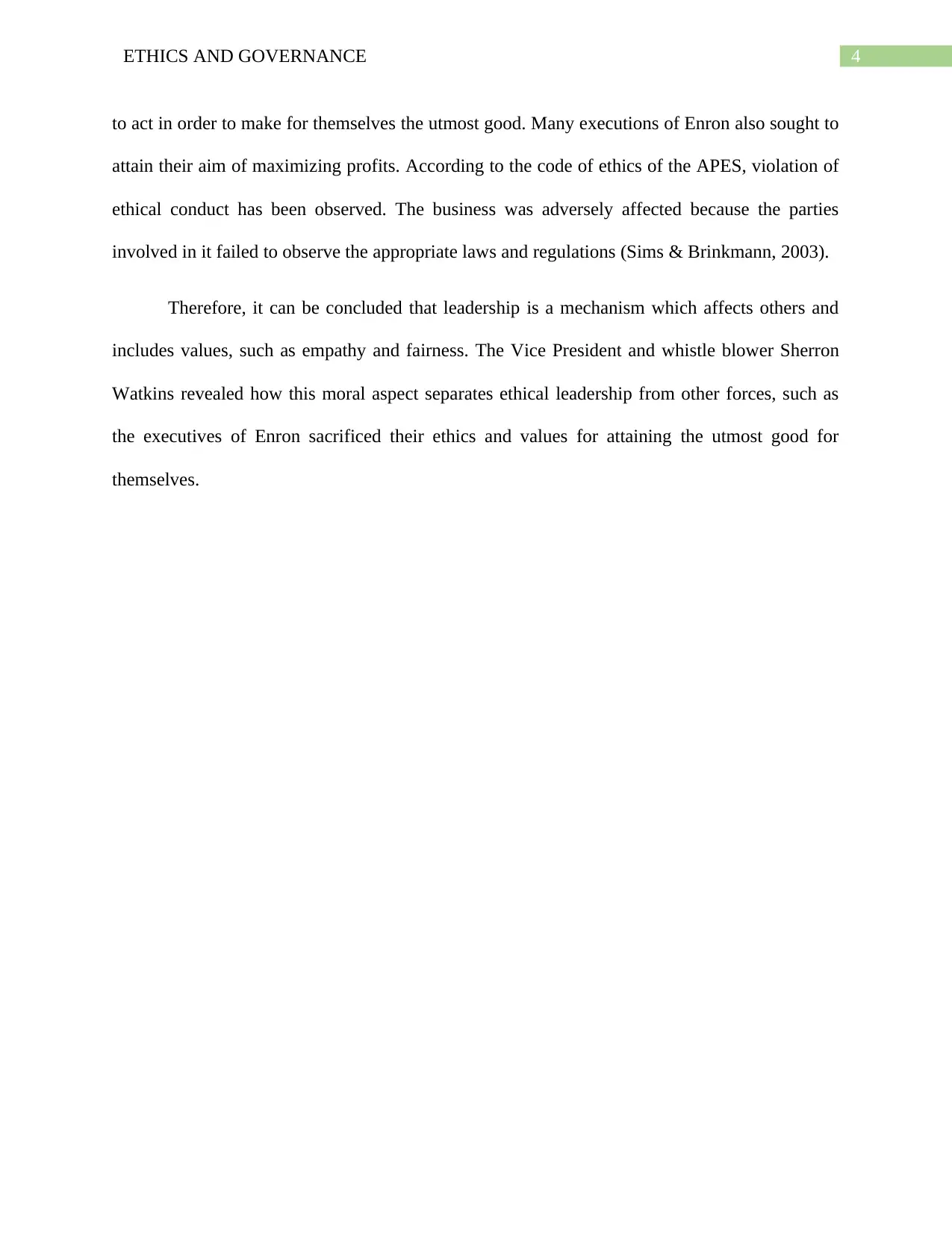
4ETHICS AND GOVERNANCE
to act in order to make for themselves the utmost good. Many executions of Enron also sought to
attain their aim of maximizing profits. According to the code of ethics of the APES, violation of
ethical conduct has been observed. The business was adversely affected because the parties
involved in it failed to observe the appropriate laws and regulations (Sims & Brinkmann, 2003).
Therefore, it can be concluded that leadership is a mechanism which affects others and
includes values, such as empathy and fairness. The Vice President and whistle blower Sherron
Watkins revealed how this moral aspect separates ethical leadership from other forces, such as
the executives of Enron sacrificed their ethics and values for attaining the utmost good for
themselves.
to act in order to make for themselves the utmost good. Many executions of Enron also sought to
attain their aim of maximizing profits. According to the code of ethics of the APES, violation of
ethical conduct has been observed. The business was adversely affected because the parties
involved in it failed to observe the appropriate laws and regulations (Sims & Brinkmann, 2003).
Therefore, it can be concluded that leadership is a mechanism which affects others and
includes values, such as empathy and fairness. The Vice President and whistle blower Sherron
Watkins revealed how this moral aspect separates ethical leadership from other forces, such as
the executives of Enron sacrificed their ethics and values for attaining the utmost good for
themselves.
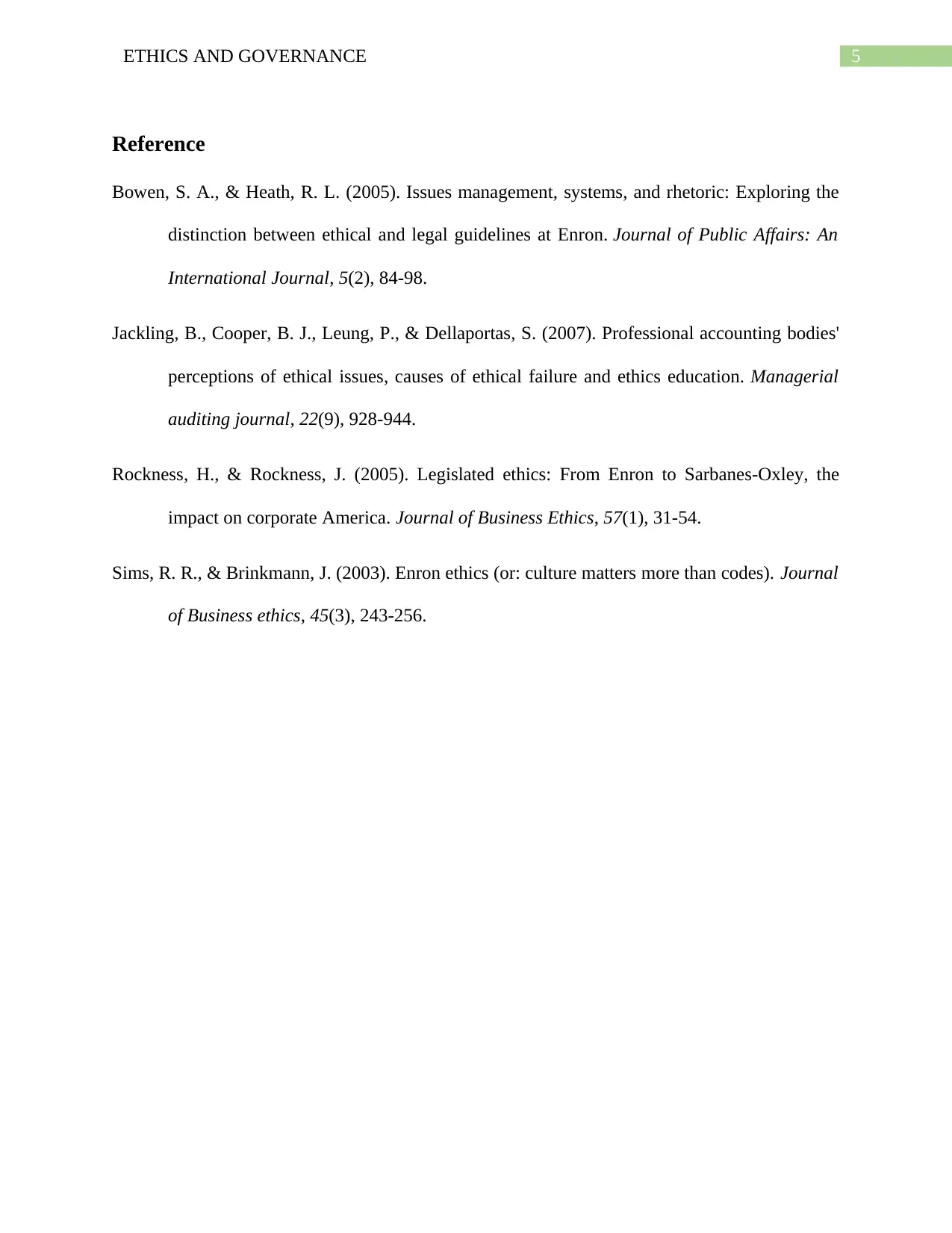
5ETHICS AND GOVERNANCE
Reference
Bowen, S. A., & Heath, R. L. (2005). Issues management, systems, and rhetoric: Exploring the
distinction between ethical and legal guidelines at Enron. Journal of Public Affairs: An
International Journal, 5(2), 84-98.
Jackling, B., Cooper, B. J., Leung, P., & Dellaportas, S. (2007). Professional accounting bodies'
perceptions of ethical issues, causes of ethical failure and ethics education. Managerial
auditing journal, 22(9), 928-944.
Rockness, H., & Rockness, J. (2005). Legislated ethics: From Enron to Sarbanes-Oxley, the
impact on corporate America. Journal of Business Ethics, 57(1), 31-54.
Sims, R. R., & Brinkmann, J. (2003). Enron ethics (or: culture matters more than codes). Journal
of Business ethics, 45(3), 243-256.
Reference
Bowen, S. A., & Heath, R. L. (2005). Issues management, systems, and rhetoric: Exploring the
distinction between ethical and legal guidelines at Enron. Journal of Public Affairs: An
International Journal, 5(2), 84-98.
Jackling, B., Cooper, B. J., Leung, P., & Dellaportas, S. (2007). Professional accounting bodies'
perceptions of ethical issues, causes of ethical failure and ethics education. Managerial
auditing journal, 22(9), 928-944.
Rockness, H., & Rockness, J. (2005). Legislated ethics: From Enron to Sarbanes-Oxley, the
impact on corporate America. Journal of Business Ethics, 57(1), 31-54.
Sims, R. R., & Brinkmann, J. (2003). Enron ethics (or: culture matters more than codes). Journal
of Business ethics, 45(3), 243-256.
⊘ This is a preview!⊘
Do you want full access?
Subscribe today to unlock all pages.

Trusted by 1+ million students worldwide
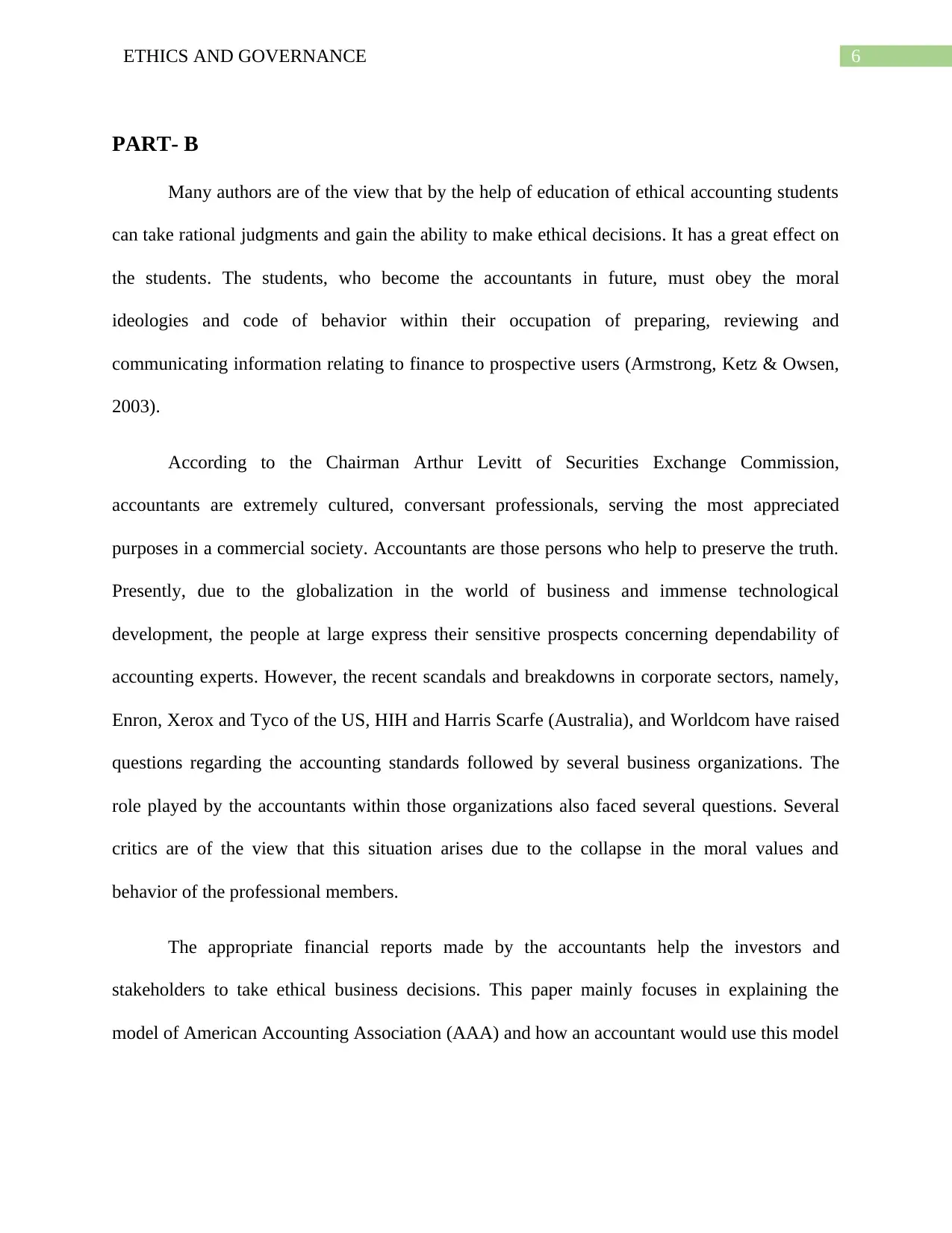
6ETHICS AND GOVERNANCE
PART- B
Many authors are of the view that by the help of education of ethical accounting students
can take rational judgments and gain the ability to make ethical decisions. It has a great effect on
the students. The students, who become the accountants in future, must obey the moral
ideologies and code of behavior within their occupation of preparing, reviewing and
communicating information relating to finance to prospective users (Armstrong, Ketz & Owsen,
2003).
According to the Chairman Arthur Levitt of Securities Exchange Commission,
accountants are extremely cultured, conversant professionals, serving the most appreciated
purposes in a commercial society. Accountants are those persons who help to preserve the truth.
Presently, due to the globalization in the world of business and immense technological
development, the people at large express their sensitive prospects concerning dependability of
accounting experts. However, the recent scandals and breakdowns in corporate sectors, namely,
Enron, Xerox and Tyco of the US, HIH and Harris Scarfe (Australia), and Worldcom have raised
questions regarding the accounting standards followed by several business organizations. The
role played by the accountants within those organizations also faced several questions. Several
critics are of the view that this situation arises due to the collapse in the moral values and
behavior of the professional members.
The appropriate financial reports made by the accountants help the investors and
stakeholders to take ethical business decisions. This paper mainly focuses in explaining the
model of American Accounting Association (AAA) and how an accountant would use this model
PART- B
Many authors are of the view that by the help of education of ethical accounting students
can take rational judgments and gain the ability to make ethical decisions. It has a great effect on
the students. The students, who become the accountants in future, must obey the moral
ideologies and code of behavior within their occupation of preparing, reviewing and
communicating information relating to finance to prospective users (Armstrong, Ketz & Owsen,
2003).
According to the Chairman Arthur Levitt of Securities Exchange Commission,
accountants are extremely cultured, conversant professionals, serving the most appreciated
purposes in a commercial society. Accountants are those persons who help to preserve the truth.
Presently, due to the globalization in the world of business and immense technological
development, the people at large express their sensitive prospects concerning dependability of
accounting experts. However, the recent scandals and breakdowns in corporate sectors, namely,
Enron, Xerox and Tyco of the US, HIH and Harris Scarfe (Australia), and Worldcom have raised
questions regarding the accounting standards followed by several business organizations. The
role played by the accountants within those organizations also faced several questions. Several
critics are of the view that this situation arises due to the collapse in the moral values and
behavior of the professional members.
The appropriate financial reports made by the accountants help the investors and
stakeholders to take ethical business decisions. This paper mainly focuses in explaining the
model of American Accounting Association (AAA) and how an accountant would use this model
Paraphrase This Document
Need a fresh take? Get an instant paraphrase of this document with our AI Paraphraser
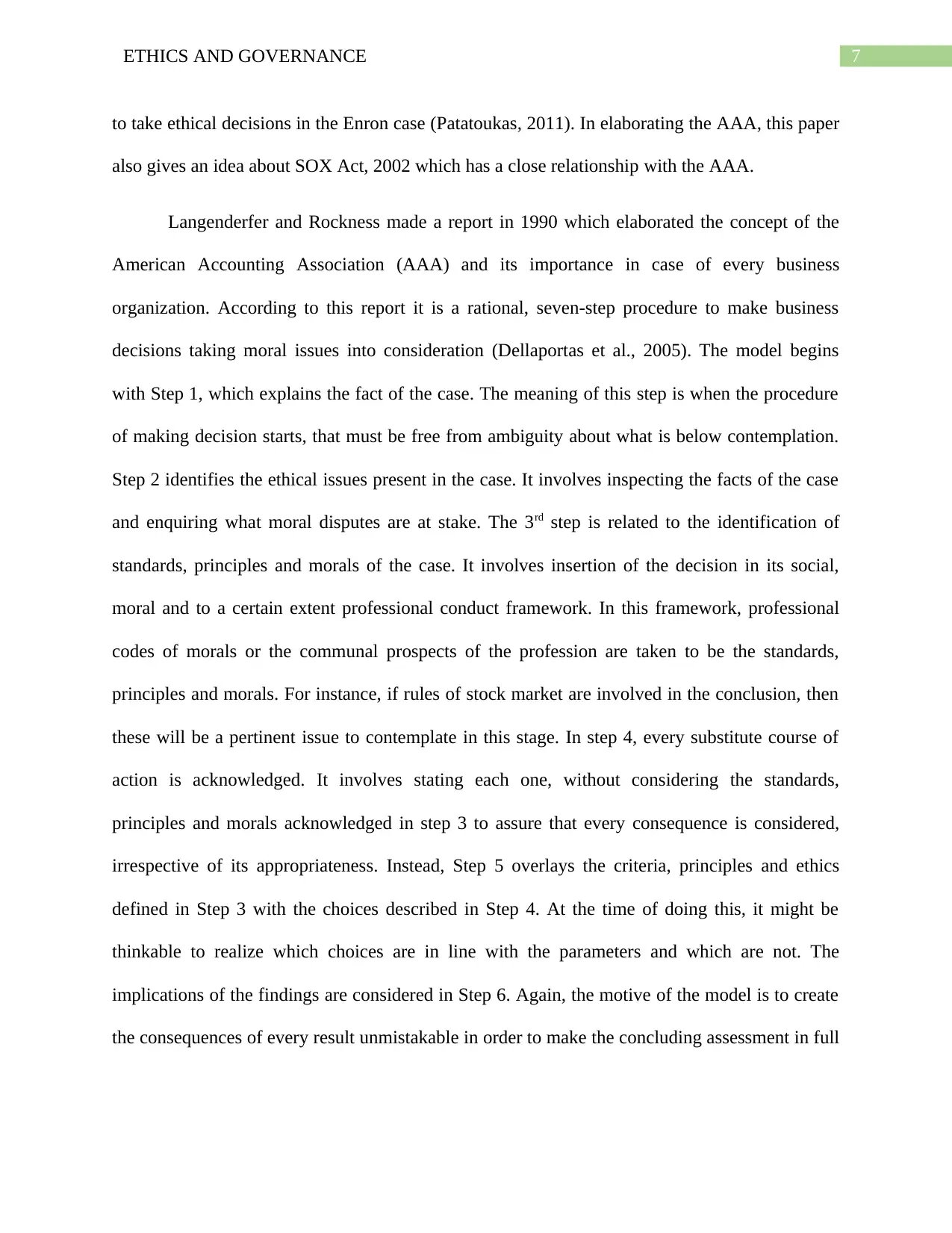
7ETHICS AND GOVERNANCE
to take ethical decisions in the Enron case (Patatoukas, 2011). In elaborating the AAA, this paper
also gives an idea about SOX Act, 2002 which has a close relationship with the AAA.
Langenderfer and Rockness made a report in 1990 which elaborated the concept of the
American Accounting Association (AAA) and its importance in case of every business
organization. According to this report it is a rational, seven-step procedure to make business
decisions taking moral issues into consideration (Dellaportas et al., 2005). The model begins
with Step 1, which explains the fact of the case. The meaning of this step is when the procedure
of making decision starts, that must be free from ambiguity about what is below contemplation.
Step 2 identifies the ethical issues present in the case. It involves inspecting the facts of the case
and enquiring what moral disputes are at stake. The 3rd step is related to the identification of
standards, principles and morals of the case. It involves insertion of the decision in its social,
moral and to a certain extent professional conduct framework. In this framework, professional
codes of morals or the communal prospects of the profession are taken to be the standards,
principles and morals. For instance, if rules of stock market are involved in the conclusion, then
these will be a pertinent issue to contemplate in this stage. In step 4, every substitute course of
action is acknowledged. It involves stating each one, without considering the standards,
principles and morals acknowledged in step 3 to assure that every consequence is considered,
irrespective of its appropriateness. Instead, Step 5 overlays the criteria, principles and ethics
defined in Step 3 with the choices described in Step 4. At the time of doing this, it might be
thinkable to realize which choices are in line with the parameters and which are not. The
implications of the findings are considered in Step 6. Again, the motive of the model is to create
the consequences of every result unmistakable in order to make the concluding assessment in full
to take ethical decisions in the Enron case (Patatoukas, 2011). In elaborating the AAA, this paper
also gives an idea about SOX Act, 2002 which has a close relationship with the AAA.
Langenderfer and Rockness made a report in 1990 which elaborated the concept of the
American Accounting Association (AAA) and its importance in case of every business
organization. According to this report it is a rational, seven-step procedure to make business
decisions taking moral issues into consideration (Dellaportas et al., 2005). The model begins
with Step 1, which explains the fact of the case. The meaning of this step is when the procedure
of making decision starts, that must be free from ambiguity about what is below contemplation.
Step 2 identifies the ethical issues present in the case. It involves inspecting the facts of the case
and enquiring what moral disputes are at stake. The 3rd step is related to the identification of
standards, principles and morals of the case. It involves insertion of the decision in its social,
moral and to a certain extent professional conduct framework. In this framework, professional
codes of morals or the communal prospects of the profession are taken to be the standards,
principles and morals. For instance, if rules of stock market are involved in the conclusion, then
these will be a pertinent issue to contemplate in this stage. In step 4, every substitute course of
action is acknowledged. It involves stating each one, without considering the standards,
principles and morals acknowledged in step 3 to assure that every consequence is considered,
irrespective of its appropriateness. Instead, Step 5 overlays the criteria, principles and ethics
defined in Step 3 with the choices described in Step 4. At the time of doing this, it might be
thinkable to realize which choices are in line with the parameters and which are not. The
implications of the findings are considered in Step 6. Again, the motive of the model is to create
the consequences of every result unmistakable in order to make the concluding assessment in full
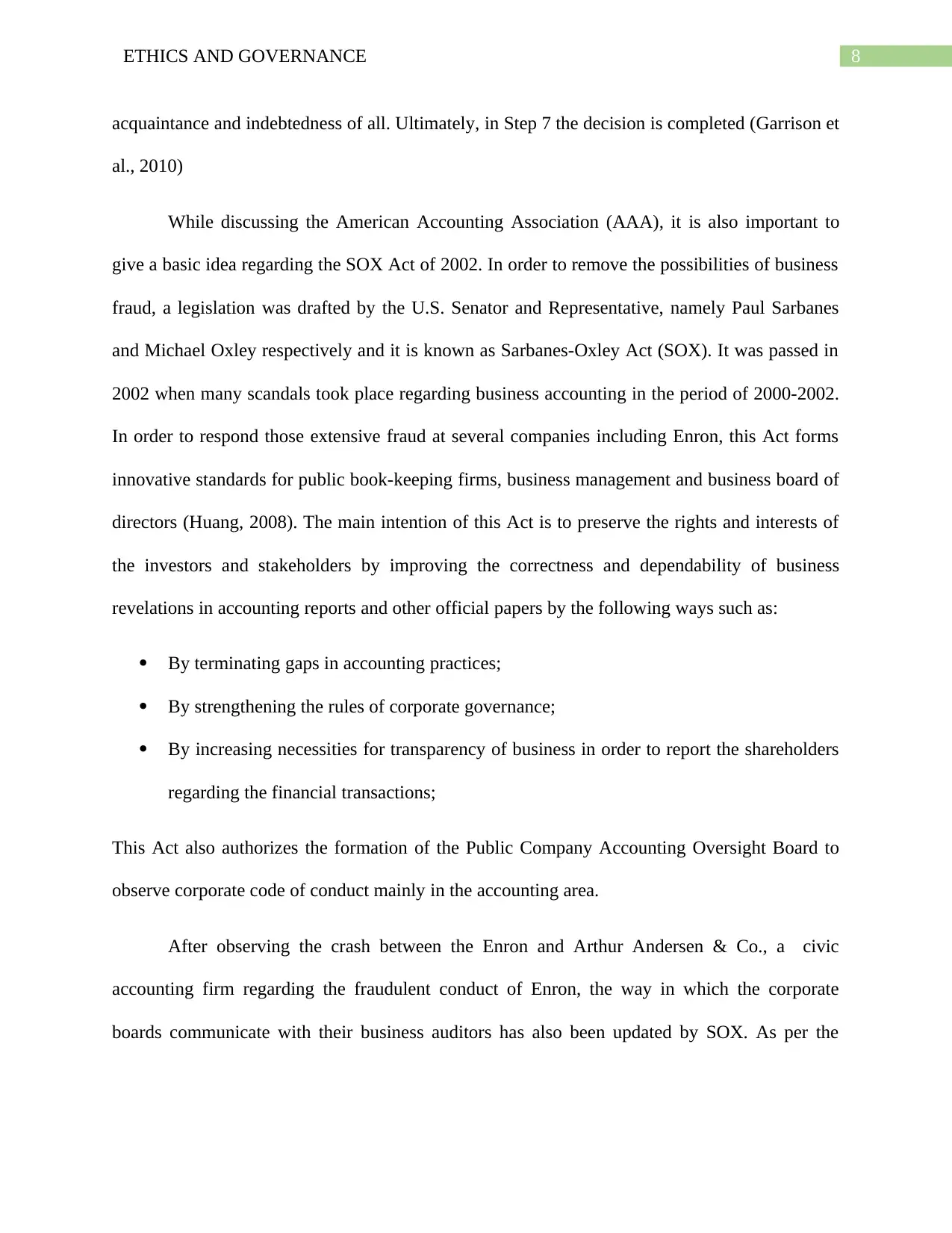
8ETHICS AND GOVERNANCE
acquaintance and indebtedness of all. Ultimately, in Step 7 the decision is completed (Garrison et
al., 2010)
While discussing the American Accounting Association (AAA), it is also important to
give a basic idea regarding the SOX Act of 2002. In order to remove the possibilities of business
fraud, a legislation was drafted by the U.S. Senator and Representative, namely Paul Sarbanes
and Michael Oxley respectively and it is known as Sarbanes-Oxley Act (SOX). It was passed in
2002 when many scandals took place regarding business accounting in the period of 2000-2002.
In order to respond those extensive fraud at several companies including Enron, this Act forms
innovative standards for public book-keeping firms, business management and business board of
directors (Huang, 2008). The main intention of this Act is to preserve the rights and interests of
the investors and stakeholders by improving the correctness and dependability of business
revelations in accounting reports and other official papers by the following ways such as:
By terminating gaps in accounting practices;
By strengthening the rules of corporate governance;
By increasing necessities for transparency of business in order to report the shareholders
regarding the financial transactions;
This Act also authorizes the formation of the Public Company Accounting Oversight Board to
observe corporate code of conduct mainly in the accounting area.
After observing the crash between the Enron and Arthur Andersen & Co., a civic
accounting firm regarding the fraudulent conduct of Enron, the way in which the corporate
boards communicate with their business auditors has also been updated by SOX. As per the
acquaintance and indebtedness of all. Ultimately, in Step 7 the decision is completed (Garrison et
al., 2010)
While discussing the American Accounting Association (AAA), it is also important to
give a basic idea regarding the SOX Act of 2002. In order to remove the possibilities of business
fraud, a legislation was drafted by the U.S. Senator and Representative, namely Paul Sarbanes
and Michael Oxley respectively and it is known as Sarbanes-Oxley Act (SOX). It was passed in
2002 when many scandals took place regarding business accounting in the period of 2000-2002.
In order to respond those extensive fraud at several companies including Enron, this Act forms
innovative standards for public book-keeping firms, business management and business board of
directors (Huang, 2008). The main intention of this Act is to preserve the rights and interests of
the investors and stakeholders by improving the correctness and dependability of business
revelations in accounting reports and other official papers by the following ways such as:
By terminating gaps in accounting practices;
By strengthening the rules of corporate governance;
By increasing necessities for transparency of business in order to report the shareholders
regarding the financial transactions;
This Act also authorizes the formation of the Public Company Accounting Oversight Board to
observe corporate code of conduct mainly in the accounting area.
After observing the crash between the Enron and Arthur Andersen & Co., a civic
accounting firm regarding the fraudulent conduct of Enron, the way in which the corporate
boards communicate with their business auditors has also been updated by SOX. As per the
⊘ This is a preview!⊘
Do you want full access?
Subscribe today to unlock all pages.

Trusted by 1+ million students worldwide
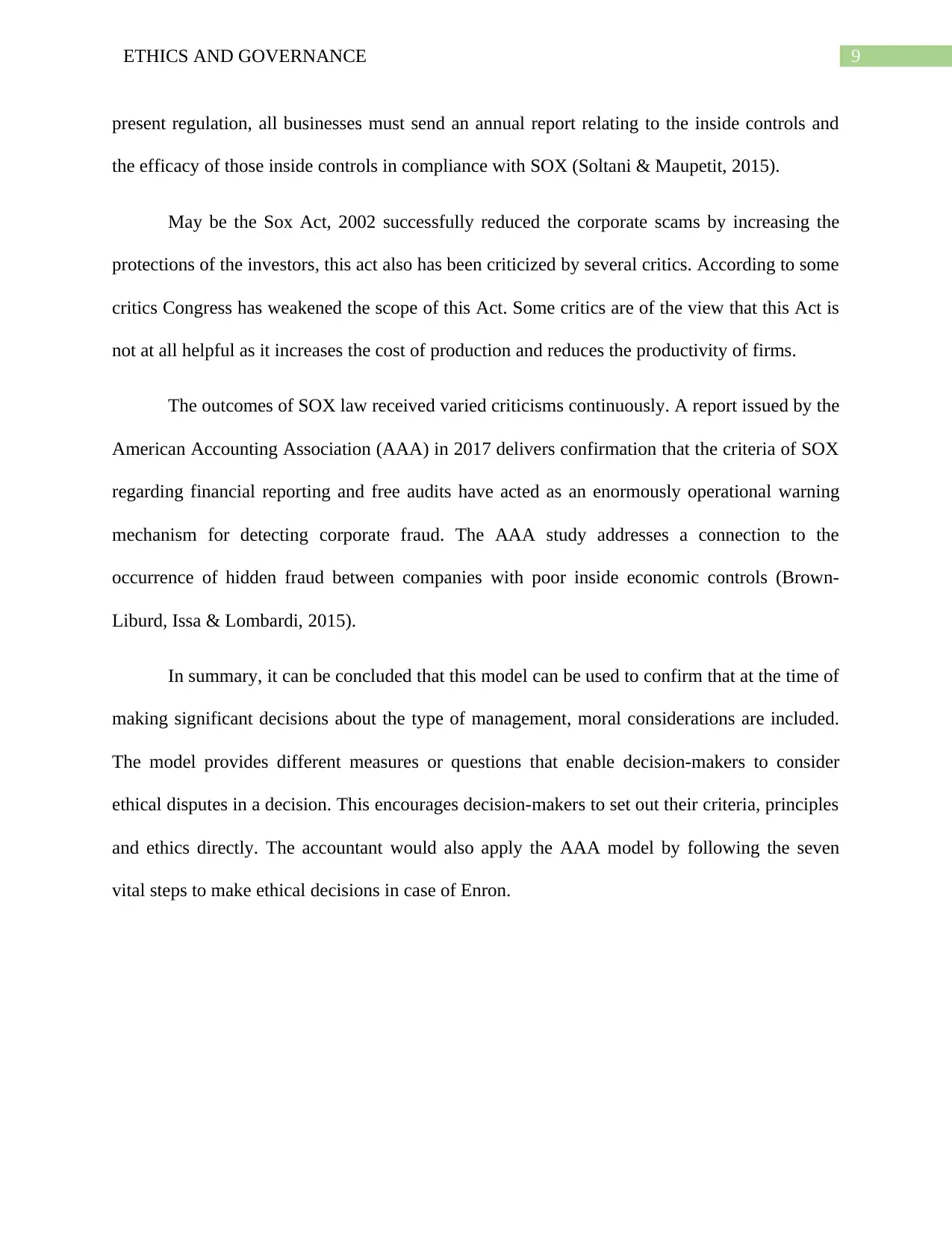
9ETHICS AND GOVERNANCE
present regulation, all businesses must send an annual report relating to the inside controls and
the efficacy of those inside controls in compliance with SOX (Soltani & Maupetit, 2015).
May be the Sox Act, 2002 successfully reduced the corporate scams by increasing the
protections of the investors, this act also has been criticized by several critics. According to some
critics Congress has weakened the scope of this Act. Some critics are of the view that this Act is
not at all helpful as it increases the cost of production and reduces the productivity of firms.
The outcomes of SOX law received varied criticisms continuously. A report issued by the
American Accounting Association (AAA) in 2017 delivers confirmation that the criteria of SOX
regarding financial reporting and free audits have acted as an enormously operational warning
mechanism for detecting corporate fraud. The AAA study addresses a connection to the
occurrence of hidden fraud between companies with poor inside economic controls (Brown-
Liburd, Issa & Lombardi, 2015).
In summary, it can be concluded that this model can be used to confirm that at the time of
making significant decisions about the type of management, moral considerations are included.
The model provides different measures or questions that enable decision-makers to consider
ethical disputes in a decision. This encourages decision-makers to set out their criteria, principles
and ethics directly. The accountant would also apply the AAA model by following the seven
vital steps to make ethical decisions in case of Enron.
present regulation, all businesses must send an annual report relating to the inside controls and
the efficacy of those inside controls in compliance with SOX (Soltani & Maupetit, 2015).
May be the Sox Act, 2002 successfully reduced the corporate scams by increasing the
protections of the investors, this act also has been criticized by several critics. According to some
critics Congress has weakened the scope of this Act. Some critics are of the view that this Act is
not at all helpful as it increases the cost of production and reduces the productivity of firms.
The outcomes of SOX law received varied criticisms continuously. A report issued by the
American Accounting Association (AAA) in 2017 delivers confirmation that the criteria of SOX
regarding financial reporting and free audits have acted as an enormously operational warning
mechanism for detecting corporate fraud. The AAA study addresses a connection to the
occurrence of hidden fraud between companies with poor inside economic controls (Brown-
Liburd, Issa & Lombardi, 2015).
In summary, it can be concluded that this model can be used to confirm that at the time of
making significant decisions about the type of management, moral considerations are included.
The model provides different measures or questions that enable decision-makers to consider
ethical disputes in a decision. This encourages decision-makers to set out their criteria, principles
and ethics directly. The accountant would also apply the AAA model by following the seven
vital steps to make ethical decisions in case of Enron.
Paraphrase This Document
Need a fresh take? Get an instant paraphrase of this document with our AI Paraphraser
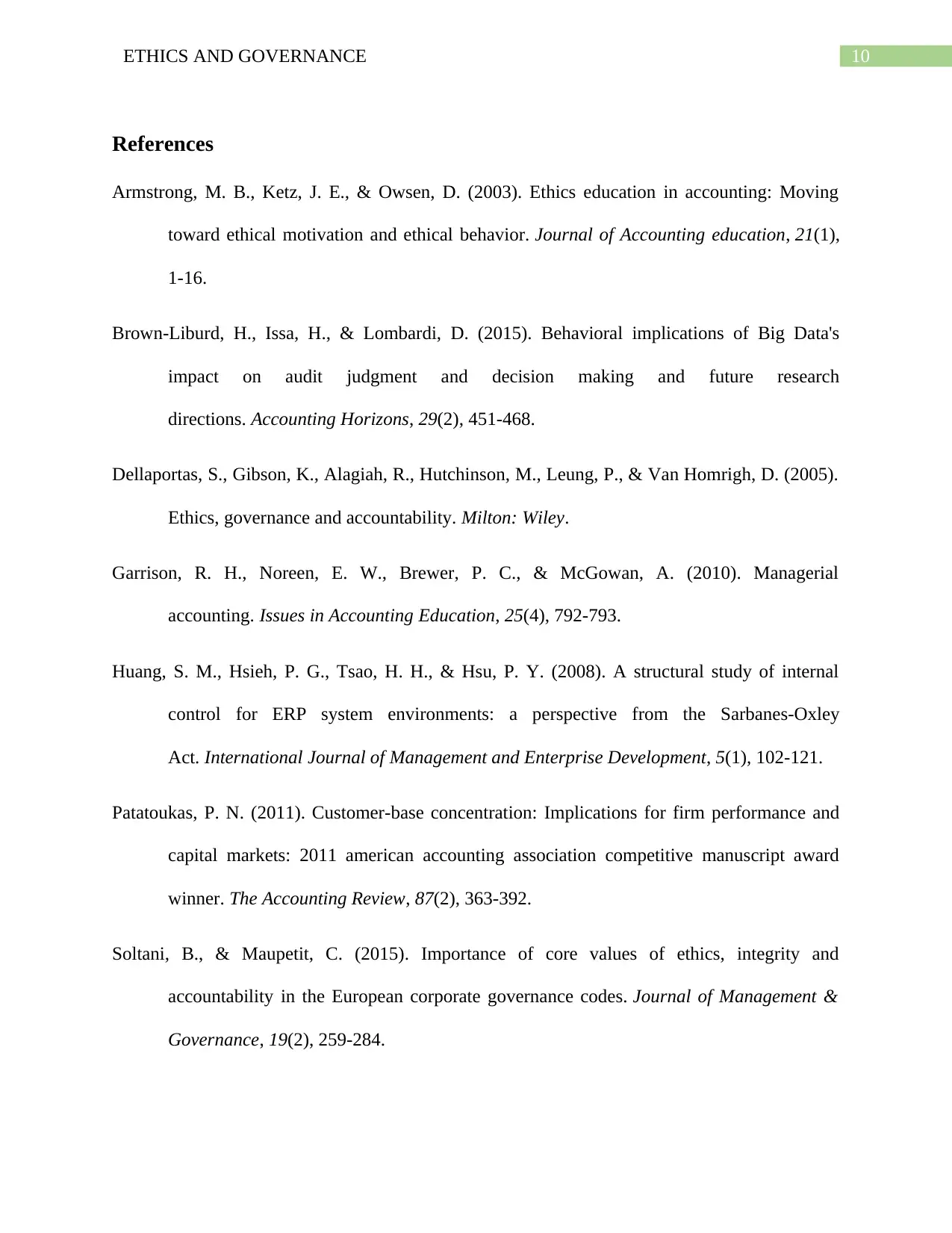
10ETHICS AND GOVERNANCE
References
Armstrong, M. B., Ketz, J. E., & Owsen, D. (2003). Ethics education in accounting: Moving
toward ethical motivation and ethical behavior. Journal of Accounting education, 21(1),
1-16.
Brown-Liburd, H., Issa, H., & Lombardi, D. (2015). Behavioral implications of Big Data's
impact on audit judgment and decision making and future research
directions. Accounting Horizons, 29(2), 451-468.
Dellaportas, S., Gibson, K., Alagiah, R., Hutchinson, M., Leung, P., & Van Homrigh, D. (2005).
Ethics, governance and accountability. Milton: Wiley.
Garrison, R. H., Noreen, E. W., Brewer, P. C., & McGowan, A. (2010). Managerial
accounting. Issues in Accounting Education, 25(4), 792-793.
Huang, S. M., Hsieh, P. G., Tsao, H. H., & Hsu, P. Y. (2008). A structural study of internal
control for ERP system environments: a perspective from the Sarbanes-Oxley
Act. International Journal of Management and Enterprise Development, 5(1), 102-121.
Patatoukas, P. N. (2011). Customer-base concentration: Implications for firm performance and
capital markets: 2011 american accounting association competitive manuscript award
winner. The Accounting Review, 87(2), 363-392.
Soltani, B., & Maupetit, C. (2015). Importance of core values of ethics, integrity and
accountability in the European corporate governance codes. Journal of Management &
Governance, 19(2), 259-284.
References
Armstrong, M. B., Ketz, J. E., & Owsen, D. (2003). Ethics education in accounting: Moving
toward ethical motivation and ethical behavior. Journal of Accounting education, 21(1),
1-16.
Brown-Liburd, H., Issa, H., & Lombardi, D. (2015). Behavioral implications of Big Data's
impact on audit judgment and decision making and future research
directions. Accounting Horizons, 29(2), 451-468.
Dellaportas, S., Gibson, K., Alagiah, R., Hutchinson, M., Leung, P., & Van Homrigh, D. (2005).
Ethics, governance and accountability. Milton: Wiley.
Garrison, R. H., Noreen, E. W., Brewer, P. C., & McGowan, A. (2010). Managerial
accounting. Issues in Accounting Education, 25(4), 792-793.
Huang, S. M., Hsieh, P. G., Tsao, H. H., & Hsu, P. Y. (2008). A structural study of internal
control for ERP system environments: a perspective from the Sarbanes-Oxley
Act. International Journal of Management and Enterprise Development, 5(1), 102-121.
Patatoukas, P. N. (2011). Customer-base concentration: Implications for firm performance and
capital markets: 2011 american accounting association competitive manuscript award
winner. The Accounting Review, 87(2), 363-392.
Soltani, B., & Maupetit, C. (2015). Importance of core values of ethics, integrity and
accountability in the European corporate governance codes. Journal of Management &
Governance, 19(2), 259-284.
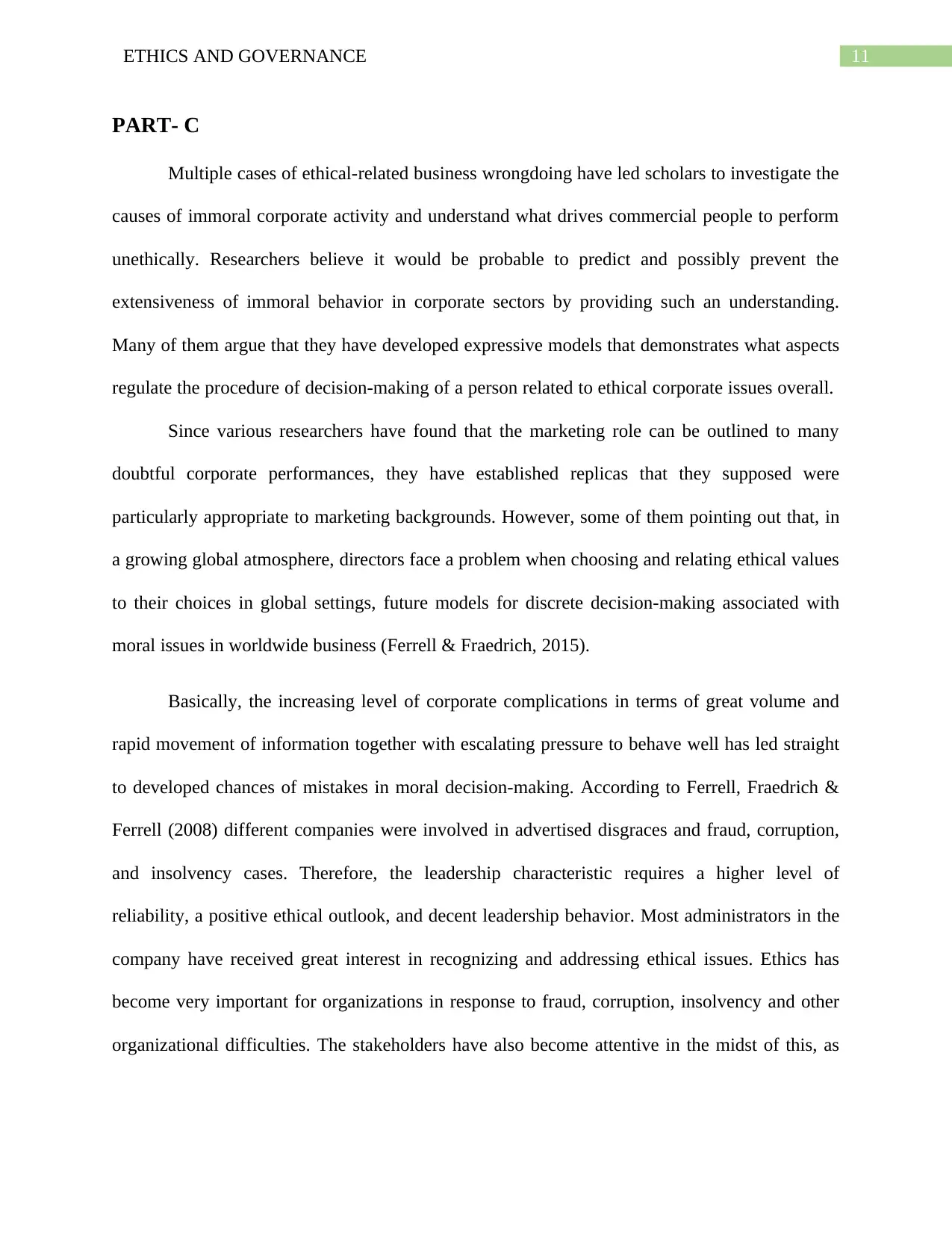
11ETHICS AND GOVERNANCE
PART- C
Multiple cases of ethical-related business wrongdoing have led scholars to investigate the
causes of immoral corporate activity and understand what drives commercial people to perform
unethically. Researchers believe it would be probable to predict and possibly prevent the
extensiveness of immoral behavior in corporate sectors by providing such an understanding.
Many of them argue that they have developed expressive models that demonstrates what aspects
regulate the procedure of decision-making of a person related to ethical corporate issues overall.
Since various researchers have found that the marketing role can be outlined to many
doubtful corporate performances, they have established replicas that they supposed were
particularly appropriate to marketing backgrounds. However, some of them pointing out that, in
a growing global atmosphere, directors face a problem when choosing and relating ethical values
to their choices in global settings, future models for discrete decision-making associated with
moral issues in worldwide business (Ferrell & Fraedrich, 2015).
Basically, the increasing level of corporate complications in terms of great volume and
rapid movement of information together with escalating pressure to behave well has led straight
to developed chances of mistakes in moral decision-making. According to Ferrell, Fraedrich &
Ferrell (2008) different companies were involved in advertised disgraces and fraud, corruption,
and insolvency cases. Therefore, the leadership characteristic requires a higher level of
reliability, a positive ethical outlook, and decent leadership behavior. Most administrators in the
company have received great interest in recognizing and addressing ethical issues. Ethics has
become very important for organizations in response to fraud, corruption, insolvency and other
organizational difficulties. The stakeholders have also become attentive in the midst of this, as
PART- C
Multiple cases of ethical-related business wrongdoing have led scholars to investigate the
causes of immoral corporate activity and understand what drives commercial people to perform
unethically. Researchers believe it would be probable to predict and possibly prevent the
extensiveness of immoral behavior in corporate sectors by providing such an understanding.
Many of them argue that they have developed expressive models that demonstrates what aspects
regulate the procedure of decision-making of a person related to ethical corporate issues overall.
Since various researchers have found that the marketing role can be outlined to many
doubtful corporate performances, they have established replicas that they supposed were
particularly appropriate to marketing backgrounds. However, some of them pointing out that, in
a growing global atmosphere, directors face a problem when choosing and relating ethical values
to their choices in global settings, future models for discrete decision-making associated with
moral issues in worldwide business (Ferrell & Fraedrich, 2015).
Basically, the increasing level of corporate complications in terms of great volume and
rapid movement of information together with escalating pressure to behave well has led straight
to developed chances of mistakes in moral decision-making. According to Ferrell, Fraedrich &
Ferrell (2008) different companies were involved in advertised disgraces and fraud, corruption,
and insolvency cases. Therefore, the leadership characteristic requires a higher level of
reliability, a positive ethical outlook, and decent leadership behavior. Most administrators in the
company have received great interest in recognizing and addressing ethical issues. Ethics has
become very important for organizations in response to fraud, corruption, insolvency and other
organizational difficulties. The stakeholders have also become attentive in the midst of this, as
⊘ This is a preview!⊘
Do you want full access?
Subscribe today to unlock all pages.

Trusted by 1+ million students worldwide
1 out of 17
Related Documents
Your All-in-One AI-Powered Toolkit for Academic Success.
+13062052269
info@desklib.com
Available 24*7 on WhatsApp / Email
![[object Object]](/_next/static/media/star-bottom.7253800d.svg)
Unlock your academic potential
Copyright © 2020–2025 A2Z Services. All Rights Reserved. Developed and managed by ZUCOL.





